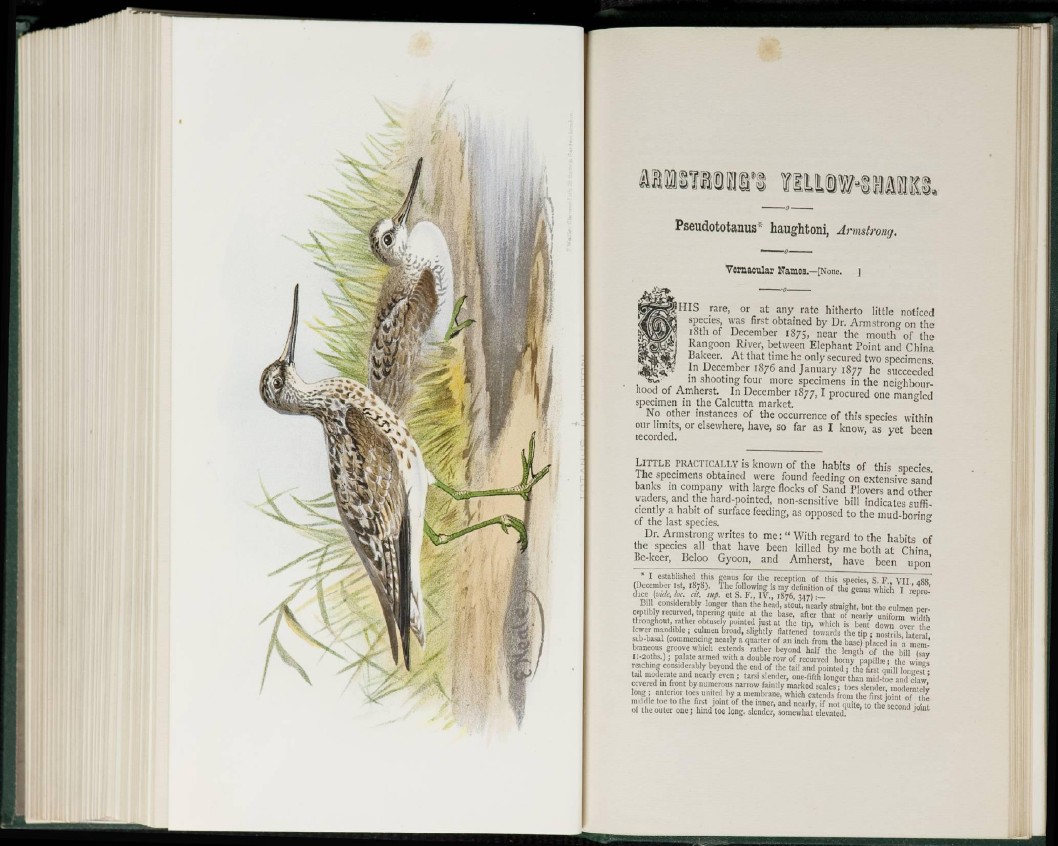
Pseudototanus:: haughtoni, Armstrong.
Vernacular ITames.—[None, j
HIS rare, or at any rate hitherto little noticed
species, was first obtained by Dr. Armstrong on the
18th of December 1875, near the mouth of the
Rangoon River, between Elephant Point and China
Bakeer. At that time he only secured two specimens.
In December 1S76 and January 1877 he succeeded
in shooting four more specimens in the neighbourhood
of Amherst. In December 1877, I procured one mangled
specimen in the Calcutta market.
No other instances of the occurrence of this species within
our limits, or elsewhere, have, so far as I know, as yet been
recorded.
LITTLE PRACTICALLY is known of the habits of this species.
The specimens obtained were found feeding on extensive sand
banks in company with large flocks of Sand Plovers and other
waders, and the hard-pointed, non-sensitive bill indicates sufficiently
a habit of surface feeding, as opposed to the mud-boring
of the last species.
Dr. Armstrong writes to me : " With regard to the habits of
the species all that have been killed by me both at China,
Be-keer, Beloo Gyoon, and Amherst, have been upon
* I established this genus for the reception of this species, S. F., VII, 488,
(December 1ST, 1878). The following is my definition of the genus which I reproduce
[vittd,loc. cit. sup. e t S . F., IV., 1876,347):—
Bill considerably longer than the head, siout, nearly straight, but the culmen perceptibly
recurved, tapering quite at the base, after that of neatly uniform width
throughout, rather obtusely pointed just at the tip, which is bent down over the
lower mandible ; culmen broad, slightly flattened towards the tip ; nostrils, lateral,
sub-basal (commencing nearly a quarter of an inch from the base) placed in a membraneous
groove which extends rather beyond half the length of the bill (say
II-2OTHS.); palate armed with a double row of recurved horny papillae ; the wings
reaching considerably beyond the end of the tail and pointed ; the first quill longest;
tail moderate and nearly even ; tarsi slender, one-fifth longer than mid-toe and claw,
covered in front by numerous narrow faintly marked scales ; toes slender, moderately
long ; anterior toes united by a membiane, which extends from the first joint of the
middle toe to the first joint of the inner, and nearly, if not finite, to the second joint
of the outer one; hind toe long, slender, somewhat elevated.